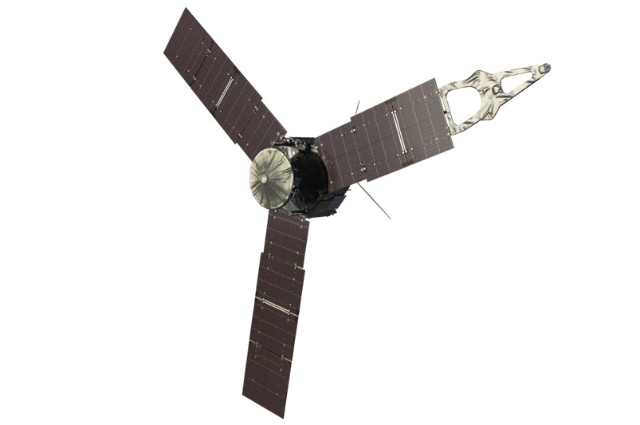Call me the giant! Every night as I gaze up at the empty sky, Jupiter asks me, "A trip to Jupiter really hits the spot.” However, the entire planet Jupiter has not yet been fully discovered by space scientists worldwide.
A black spot on Jupiter was captured on camera by NASA's robotic Juno spacecraft during one of its flybys. It appears to be a typically dark cloud feature known colloquially as the Abyss, but no one is certain of what that black spot is. Research is ongoing, and numerous hypotheses are emerging. Recently on 25th November, hopefully, the Juno spacecraft made a close pass over this planet. The scientists are eager to study the Abyss up close.
Recently on behalf of the American-based Southwest Research Institute and Malin Space Science Systems, two NASA citizen scientists, Gerald Eichstand and Sean Doran, shared the earlier image of that dark spot to pique the interest of the general public. Following that, there is an increasing interest in Jupiter and the search for the black spot.
Located fifth from the sun, Jupiter is the largest planet in the solar system. It is gastronomic, interestingly, and composed of hydrogen and helium! Ninety percent of its volume is made up of hydrogen, with ten percent coming from helium. This oblate spheroid planet has a diameter tenth of the sun's and eleven times that of Earth. It has 318 times Earth's mass! After the Moon and Venus, this planet is the third brightest natural object in the night sky.
A weak system of planetary rings with a strong magnetosphere envelops it. The solar system's largest planetary atmosphere is found there. Traces of methane, ammonia, hydrogen sulfide, water, nitrogen, sulfur, and noble gasses are present in addition to hydrogen and helium. Because of its atmosphere, this planet is mysterious. To determine if it has a rocky core or not, scientists are searching for answers. The precise amount of water that is present in its deep atmosphere is still being investigated. Researchers are trying to measure how its mass has been distributed and what causes its powerful magnetic and gravitational fields. Its deep winds, which can reach speeds of up to 620 km/h, as well as the aforesaid black spot further confound scientific understanding. NASA sent a space probe, Juno, to quench all of these desires over Jupiter.
Under the New Frontiers Program, NASA launched a number of space exploration missions to deepen our understanding of the solar system. One of the medium-class New Frontiers Programs that can offer superior scientific returns over Jupiter is Juno. This mission is occasionally referred to as New Frontiers-2. As part of this mission, on August 5, 2011, at 9:55 p.m. IST, a robotic spacecraft, Juno, built by Lockheed Martin and run by NASA's federally funded Jet Propulsion Laboratory was launched from Cape Canaveral Air Force Station in Florida, USA.
It was planned for Juno to complete 37 orbits around Jupiter during its operational period. As a result, on July 5, 2016, it entered the planet's polar orbit to start a scientific study overseen by Southwest Research Institute scientist Dr. Scott Bolton. On August 26, 2016, it made its first flyby of this planet, covering about 2.8 billion kilometers. This probe experienced its first perijove, or the moment in a spacecraft's orbit around Jupiter when it is closest to the planet's center, at 6:20:44 pm IST the following day. Unexpectedly, a black spot was observed on July 21, 2019 at 9:32:44 am IST, during its 19th perijove.
After looking at pictures of that dark area, it appeared to be encircled by cloud patterns and resembled an abyss at the center of a vortex. The abyss may actually be the deep hole that it appears to be because dark features on Jupiter's atmosphere typically run deeper than light features. However, this is only speculation in the absence of additional evidence. Light-colored high-altitude clouds occasionally atop a complex of meandering clouds and other swirling storm systems that encircle the Abyss.
The dark spot's featured image was taken as Juno was only 15,000 kilometers above the tops of Jupiter's clouds. Perseverance is going well, and everyone who enjoys space is anticipating recent 67th perijove on November 25 and the upcoming 68th perijove on December 28 of this year. According to space scientists, this Abyss has been spotted on the 67th perijove, which will improve research and provide solid proof to solve the mystery.
Everyone thinks that Juno's name was inspired by Greek and Roman mythology, but NASA actually calls it Jupiter Near-polar Orbiter (Ju-N-O). The nuclear-powered Galileo Orbiter, which operated as part of the outer solar mission, was the first probe to orbit Jupiter; this is the second. It is powered by solar panels and working in the inner solar mission. It was originally scheduled to shut down in February 2018 after completing 37 orbits, but it was kept in service until September 2025. In addition to completing 42 orbits, Juno must fly close to the planet's satellites, Ganymede, Europa, and Iowa. The scientific community is eagerly awaiting Juno's next visit in order to learn more about Jupiter's composition and to quench the thirst of that black spot. The formation of this planet is still unknown!

